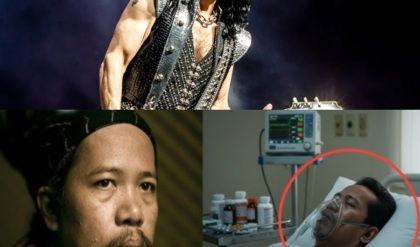NATION IN SHOCK! PAULO CAUGHT DRINKING HEAVILY—WILL KIM APPROVE OR CONDEMN? THE CONTROVERSY SWEEPING SOCIAL MEDIA AND SHAKING FANS
The Philippine entertainment industry is once again facing a wave of controversy as videos and photos of popular actor Paulo allegedly drinking heavily surfaced online. The footage, which appeared in public settings, immediately went viral, sparking massive discussion among fans and netizens. For many, seeing a celebrity they admire in such a vulnerable and seemingly irresponsible state was shocking, while others questioned the context and authenticity of the clips.

Social media erupted with opinions, speculation, and judgment. Hashtags like #PauloDrinks, #KimApproves, and #CelebrityScandal began trending across platforms like Twitter, Facebook, and Instagram. Within hours, millions of people engaged in conversations about the incident, dissecting every detail of the video. Fans expressed concern for Paulo’s well-being, debate over his choices, and curiosity about how his partner, actress Kim, might react to the situation.
Kim’s potential reaction quickly became a central point of public attention. Fans wondered whether she would publicly condone or disapprove of Paulo’s actions, or whether she would handle the matter privately. Every movement, comment, or post from her was analyzed for hidden meanings, reflecting the intense scrutiny faced by celebrity couples in the public eye. Some speculated that silence could indicate tolerance or acceptance, while a clear statement might demonstrate boundaries and assert expectations.
The incident also highlighted the pressures of fame and the double standards faced by public figures. Paulo, widely admired for his professionalism, charm, and positive public image, was suddenly seen in a contrasting light. For some fans, this discrepancy was jarring, and their disappointment was evident. Others called for understanding and empathy, emphasizing that even celebrities have moments of personal choice and vulnerability that should not define them entirely.
The discussion online quickly evolved into debates about accountability and role-model behavior. Many argued that public figures have a responsibility to act responsibly because their actions influence their fans, especially younger audiences. Others stressed the importance of distinguishing between private life and public behavior, noting that a single incident does not necessarily reflect a person’s character or moral compass.

Kim’s role in this controversy further amplified the debate. In the eyes of the public, her response—or perceived response—symbolized the health of their relationship. Supporters hoped for understanding and private resolution, while critics argued that public accountability was necessary to maintain transparency and trust. The scrutiny of her reaction reflects broader societal expectations placed on female partners in high-profile relationships, where the burden of maintaining relational harmony often falls disproportionately on women.
Psychologists and cultural commentators have noted that the incident is an example of social amplification in the digital age. A private choice, such as drinking in public, becomes magnified due to viral dissemination on social media. Every post, share, and comment contributes to a narrative that can rapidly shape public perception. The speed and intensity of online reactions often surpass the ability of the individuals involved to respond, placing additional pressure on both Paulo and Kim.
Media coverage has also intensified the situation. Entertainment news outlets and online publications reported extensively on the incident, analyzing both the visual evidence and potential repercussions for the couple’s careers. Industry experts noted that celebrity behavior is highly symbolic, often serving as a reflection of societal norms, ethics, and expectations. Consequently, even seemingly minor incidents are interpreted through a moral lens and carry significant weight in the public discourse.
Fans’ reactions have been polarized. Supporters emphasize empathy, recognizing that celebrities are human and susceptible to personal choices that do not define their entire character. Critics, on the other hand, insist that public figures must be accountable for their actions, particularly when those actions occur in public or can influence audiences. This division underscores the complex dynamics of celebrity culture in the Philippines, where admiration and scrutiny coexist in equal measure.
The controversy has also raised questions about the stability of Paulo and Kim’s relationship. Fans speculated about how this incident might impact their trust, mutual respect, and long-term compatibility. Social media became a platform for evaluating relationship dynamics, where every reaction, post, or silence is interpreted as indicative of personal feelings and relational health. In this environment, the couple’s private decisions are often treated as public statements, adding stress to their personal lives.
Industry insiders warn that how the couple handles this incident could have lasting implications. Endorsements, casting opportunities, and public appearances may be affected by the public’s perception of their behavior and relationship. Strategically managing the narrative, responding thoughtfully to media inquiries, and engaging with fans in a measured manner will be crucial to maintaining professional reputations and personal integrity.
The incident also sheds light on broader societal conversations about gender expectations and relational responsibility. Female partners of male celebrities are often expected to manage or moderate their partner’s behavior, a dynamic that places disproportionate pressure on women in high-profile relationships. Kim’s handling of the situation has been closely observed, with public interpretations of her actions reflecting broader expectations about morality, loyalty, and relational authority.
Social media’s role in shaping the narrative cannot be overstated. Posts, comments, and reactions contribute to the rapid formation of public opinion, often before the individuals involved have an opportunity to provide context or clarification. Viral content amplifies emotions and judgments, creating an environment where speculation and rumor can take on the weight of fact. This phenomenon highlights the power—and danger—of digital culture in influencing celebrity reputation.
Experts also emphasize that the incident illustrates the balancing act required in celebrity relationships. Public scrutiny, media coverage, and fan investment mean that private decisions often carry public consequences. Trust, mutual respect, and communication become essential tools for navigating such crises, as the couple must simultaneously manage personal choices and societal expectations.
In addition to relational and personal implications, the controversy demonstrates the pressures of maintaining a public image in the digital age. Celebrities are constantly under observation, and any perceived misstep can become a national conversation. Paulo’s alleged drinking behavior and the speculation about Kim’s response reveal the intensity of scrutiny that public figures face, showing how their personal lives are deeply intertwined with their professional and public personas.
The incident has also sparked debates about accountability and forgiveness. Some argue that celebrities should be allowed room for error, with the public offering understanding and support in challenging moments. Others stress that accountability is crucial, particularly when public actions have social influence. The tension between these perspectives fuels ongoing discussions on social media, reflecting the diverse values and expectations within fan communities.
Cultural commentators have noted that celebrity behavior serves as a mirror for societal values. Paulo’s actions, combined with Kim’s potential response, have become focal points for discussions about ethics, relationship dynamics, and public responsibility. The intensity of public interest illustrates how deeply celebrity culture is embedded in the collective consciousness, shaping conversations about morality, trust, and social norms.
The controversy continues to evolve, with new reactions, theories, and discussions emerging daily. Fans are closely monitoring any updates from the couple, eagerly analyzing statements, interviews, and social media posts for insight into how the situation is being handled. The ongoing dialogue highlights the enduring fascination with celebrity relationships and the significant impact of public perception on private lives.
Psychologists observing the situation point out that the social amplification of personal behavior is a hallmark of modern celebrity culture. Even a minor incident, when amplified by social media, can create intense public scrutiny and emotional investment from fans. This dynamic emphasizes the pressures of fame and the ways in which personal decisions can become public crises.
The incident also highlights the responsibility of celebrities in shaping social discourse. Paulo and Kim’s choices, behaviors, and responses are not only scrutinized for entertainment purposes but also serve as examples for societal reflection on values, norms, and relational ethics. Public interpretation transforms private moments into symbolic events with broader cultural significance.
Fans have expressed a mixture of concern, criticism, support, and curiosity. Some have praised Paulo for his accomplishments and urged empathy, emphasizing that one moment should not define him. Others have criticized him for potential recklessness, highlighting the expectations placed on public figures to act responsibly. The debate underscores the complex interaction between admiration, scrutiny, and social accountability in celebrity culture.
The potential impact on the couple’s relationship remains a topic of intense speculation. Public discussions revolve around trust, respect, communication, and compatibility. Fans question whether this incident will strengthen or weaken their bond, reflecting the larger fascination with celebrity relationships as both entertainment and a source of social reflection.
Ultimately, how Paulo and Kim handle this situation will determine not only public perception but also their personal and professional trajectories. Thoughtful communication, transparency, and proactive engagement with media and fans will be key to managing potential fallout. Their responses may set a precedent for how celebrity couples navigate similar controversies in the future.
This incident serves as a reminder of the high stakes involved in celebrity life. Every action is magnified, every silence interpreted, and every relationship decision examined. The combination of social media amplification, fan engagement, and media scrutiny creates a unique environment where personal moments are transformed into national discussions.
In conclusion, the Paulo and Kim controversy is more than just a celebrity scandal. It is a reflection of societal expectations, digital-age scrutiny, and the complex interplay between private behavior and public perception. How the couple addresses the situation will influence not only their careers and relationship but also broader conversations about accountability, morality, and relational dynamics in Philippine celebrity culture.
The nation continues to watch, social media continues to buzz, and fans continue to debate. At the center of it all, Paulo and Kim navigate the difficult balance between personal choice and public expectation, demonstrating the intricate pressures of fame in the modern era. The story is ongoing, and its consequences will be felt in fan communities, media discussions, and the entertainment industry for weeks, if not months, to come.





